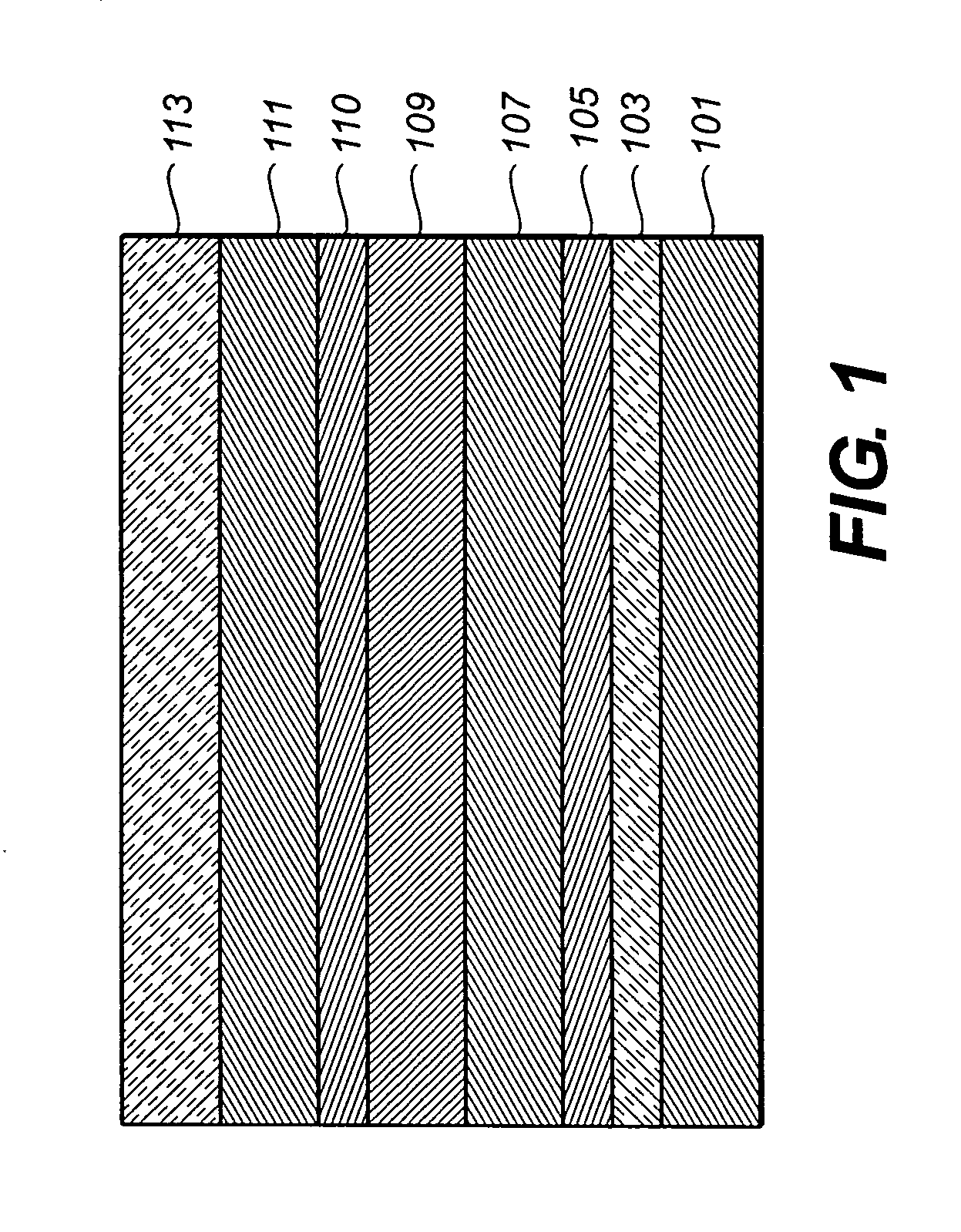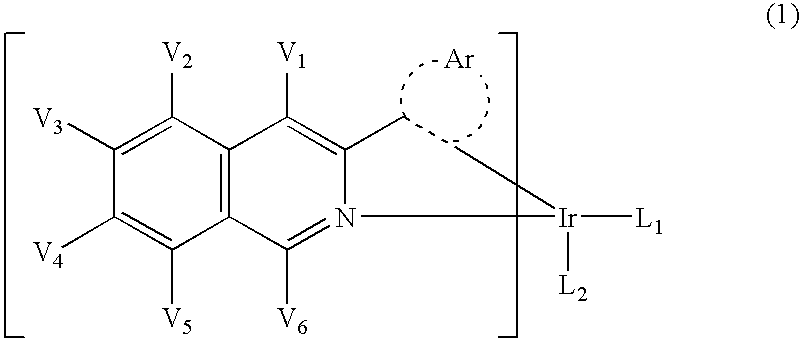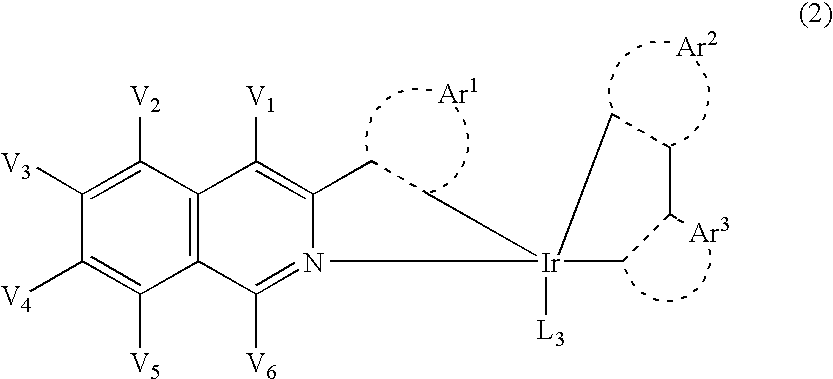Organic electroluminescent devices
a light-emitting diode and electroluminescent technology, applied in the direction of discharge tube luminescnet screens, sustainable buildings, natural mineral layered products, etc., can solve the problems of large loss of efficiency, difficult control, and performance limitations that have been a barrier to many desirable applications, and achieve the effect of useful white light emission
- Summary
- Abstract
- Description
- Claims
- Application Information
AI Technical Summary
Benefits of technology
Problems solved by technology
Method used
Image
Examples
synthetic example 1
The Synthesis of 3-Phenylisoquinoline and Iridium Complexes of 3-Phenylisoquinoline
[0158]
[0159] 3-Phenylisoquinoline was prepared by the following procedure (see Huang et al., J. Org. Chem. 67, 3437 (2000), Rxn-1). A round bottom flask containing N-(2-phenylethynylbenzylidene)-t-butyl-amine (12.7 g, 48.6 mmol) was dissolved in anhydrous DMF under a nitrogen blanket. Cuprous iodide was added and the reaction vessel was warmed to 100° C. After three hours, thin layer chromatography (dichloromethane eluant) indicated no remaining starting material. One major product was formed. The reaction mixture was cooled to room temperature and the DMF removed by distillation. The residue was taken up in dichloromethane and washed with water, brine and the organic solution dried over magnesium sulfate. Solvents were evaporated to yield 9.9 grams of crude product. This material was further purified by flash chromatography on 800 grams of silica-gel with dichloromethane as eluant. The collected fra...
example 1
Device Example 1
Evaluation of Phosphorescent Light Emitting Materials
[0163] Phosphorescent light-emitting materials were evaluated to determine if they would provide good operating lifetimes and hues. An EL device (Sample 1) was constructed in the following manner:
[0164] 1. A glass substrate coated with an 85 nm layer of indium-tin oxide (ITO) as the anode was sequentially ultrasonicated in a commercial detergent, rinsed in deionized water, degreased in toluene vapor and exposed to oxygen plasma for about 1 min.
[0165] 2. Over the ITO was deposited a 1 nm fluorocarbon (CFx) hole-injecting layer (HIL) by plasma-assisted deposition of CHF3.
[0166] A hole-transporting layer (HTL) of N,N′-di-1-naphthyl-N,N′-diphenyl-4,4′-diaminobiphenyl (NPB) having a thickness of 75 nm was then evaporated from a tantalum boat.
[0167] 3. A 35 nm light-emitting layer (LEL) of 4,4′-N,N′-dicarbazole-biphenyl (7a, CBP) and 8 wt. % fac-tris(3-phenyl-isoquinolinato) iridium (III) were then deposited onto th...
example 2
Device Example 2
[0182] An EL device (Sample 11) satisfying the requirements of the invention was constructed in the following manner:
[0183] 1. A glass substrate coated with an 85 nm layer of indium-tin oxide (ITO) as the anode was sequentially ultrasonicated in a commercial detergent, rinsed in deionized water, degreased in toluene vapor and exposed to oxygen plasma for about 1 min.
[0184] 2. Over the ITO was deposited a 1 nm fluorocarbon (CFx) hole-injecting layer (HIL) by plasma-assisted deposition of CHF3.
[0185] 3. A hole-transporting layer (HTL)of N,N′-di-1-naphthyl-N,N′-diphenyl-4,4′-diaminobiphenyl (NPB) having a thickness of 95 nm was then evaporated from a tantalum boat.
[0186] 4. A 20 nm first light-emitting layer (LEL) of host 8c and 2.5 wt. % blue light-emitting material (5c) were then deposited onto the hole-transporting layer. These materials were also evaporated from tantalum boats.
[0187] 5. A 20 nm second LEL of 4,4′-N,N′-dicarbazole-biphenyl (7a, CBP) and 8 wt. % ...
PUM
| Property | Measurement | Unit |
|---|---|---|
| thick | aaaaa | aaaaa |
| quantum efficiencies | aaaaa | aaaaa |
| quantum efficiencies | aaaaa | aaaaa |
Abstract
Description
Claims
Application Information
 Login to View More
Login to View More - R&D
- Intellectual Property
- Life Sciences
- Materials
- Tech Scout
- Unparalleled Data Quality
- Higher Quality Content
- 60% Fewer Hallucinations
Browse by: Latest US Patents, China's latest patents, Technical Efficacy Thesaurus, Application Domain, Technology Topic, Popular Technical Reports.
© 2025 PatSnap. All rights reserved.Legal|Privacy policy|Modern Slavery Act Transparency Statement|Sitemap|About US| Contact US: help@patsnap.com



